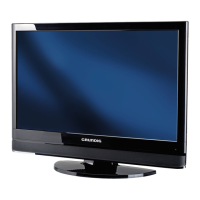
Do you have a question about the Grundig 22 VLC 2000 T and is the answer not in the manual?
Essential safety guidelines for setting up and using the television, covering placement, heat, moisture, and electrical safety.
Advice on cleaning, preventing heat build-up, avoiding moisture, and safe handling of the TV.
Overview of the TV's analogue/digital reception, TV guide, and USB media playback.
Information on the necessary antenna setup for receiving digital TV channels.
Details on the CI slot for encrypted digital channels and smart cards.
Step-by-step guide for connecting the antenna and mains power cable to the TV.
Important notes on safely plugging the TV into a mains socket.
Instructions for inserting batteries into the remote control unit.
How to tilt the television screen forward or backward.
Environmental advice for the proper disposal of used batteries.
Identification and explanation of all sockets and buttons on the TV unit.
Key buttons on the remote and their primary operations.
Explains the main buttons on the remote and their corresponding actions.
How to navigate menus and confirm selections using the remote.
Details additional remote functions for teletext, file browsing, and playback.
Specific button actions for teletext and file browser navigation.
Step-by-step guide for the automatic search of TV channels.
Setup options for language, antenna power, and country selection.
Guidance on enabling antenna power for active antennas.
Reordering, deleting, and blocking digital TV channels.
How to assign a channel to a new preset number.
Saving preferred channels into up to four favourite lists.
Procedure for removing unwanted channels.
Marking channels to be skipped during sequential channel selection.
Fine-tuning picture parameters like mode, brightness, and contrast.
Utilising features like DNR, MPEG NR, and Dynamic Contrast for picture quality.
Adjusting volume, balance, sound type, and equalizer for optimal audio.
Explanation of AVL for maintaining consistent volume across channels.
Adjusting stereo width and creating custom equalizer profiles.
Switching the TV on/off, selecting channels directly, and using the channel list.
How to choose channels from predefined lists like "All Channels" or "FAV1".
Switching the television input to external AV devices.
Method for selecting between digital (DTV) and analogue (ATV) television signals.
Adjusting the TV's sound volume and activating the mute function.
Accessing programme details and pausing the current video.
Choosing preferred audio tracks and subtitles for digital broadcasts.
Enlarging the picture and quickly switching between last viewed channels.
Options for adjusting the TV's picture aspect ratio for optimal viewing.
Explains automatic switching and manual selection of picture aspect ratios.
Using LetterBox for 16:9 content and Subtitle format for text display.
Settings for wide-screen films to adjust picture geometry.
Switching to teletext and navigating through pages.
Functions like skipping wait times, changing text size, and page stop.
Accessing specific teletext sub-pages and revealing answers.
Viewing teletext alongside TV content or in a mixed mode.
Instructions for selecting the preferred display language for TV menus.
Adjusting subtitle and audio language preferences for digital broadcasts.
Procedure to reset the TV to its original factory state.
Adjusting how long on-screen menus remain visible after input.
Enabling a PIN code to restrict access to TV menus and functions.
Steps to change the default PIN code to a personal one.
How to lock individual channels using a personal PIN code.
Setting access levels for programmes based on content suitability.
Programming the TV to automatically turn off after a set period.
Programming the TV to automatically turn on at a specific time.
Setting a timer for the TV to switch to standby mode.
Automatically turns off TV if no video signal is detected on standby.
Adjusting the time zone if it's not automatically detected.
Lists compatible video, audio, and image file types for USB playback.
Instructions for safely connecting USB media to the TV.
Information on the USB port's power limit and external adapter use.
How to view, filter, and select files from connected USB media.
Accessing and configuring settings within the USB setup menu.
Enabling the automatic preview of JPEG images in the file browser.
Adjusting the time interval between images in a slideshow.
Steps for selecting and playing media files from USB storage.
Navigating through tracks or pictures using step-by-step selection.
Using forward search to quickly advance through MP4 video playback.
Zooming into picture sections and rotating pictures by 90 degrees.
Connecting HDTV sources via HDMI for high-definition viewing.
Details on available sockets and how to connect various external devices.
Safety guidelines for connecting and powering external devices.
Connecting devices using HDMI for digital video and audio signals.
Connecting devices using YPBPR for analogue video signals.
Connecting devices using SCART for composite video and stereo audio.
Connecting to analogue TV signals using AV cinch sockets.
Selecting appropriate input signal channels for external devices.
How to plug headphones into the television's headphone socket.
Configuring volume levels for headphone output.
Instructions for linking a PC to the TV using VGA and audio cables.
How to select the PC input source on the television.
Adjusting PC display settings like resolution, frequency, and flicker.
Steps for inserting a smart card and CA module into the CI slot.
Controlling access to pay-TV channels using the CA module and PIN.
Guide to performing an automatic search for digital TV channels.
Instructions for tuning analogue TV channels automatically or manually.
How to switch the television input to analogue channels (ATV).
Tuning analogue channels by entering frequencies and preset numbers.
Adjusting analogue signal for optimal reception in areas with poor signal quality.
Managing analogue channels: deleting, preset storage, renaming, skipping.
Reordering channels within the channel list.
Assigning names (up to 8 characters) to TV channels.
Marking channels to be skipped during channel selection.
Saving preferred channels into up to four favourite lists (FAV1-FAV4).
Final step to save changes and exit the Special Settings menu.
Viewing signal properties like quality and strength for digital channels.
Steps to check for and install software updates manually.
Enabling automatic searches and installation of new software versions.
Electrical data, power consumption, sound output, screen size, and weight.
Compliance with EU directives and relevant industry standards.
Guidance on responsible product disposal and recycling.
A table listing problems, causes, and remedies for TV operation.
Note about potential interference from Class A products and user remedies.
Specific instructions for UK power plugs, fuses, and wiring connections.
Details on wire colours (blue, brown) and their terminal connections.

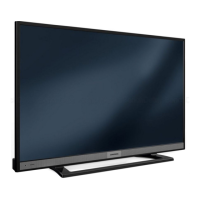
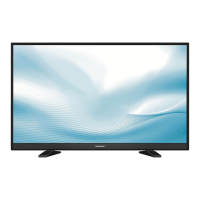



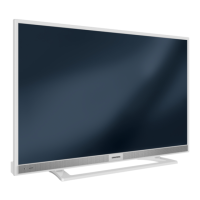
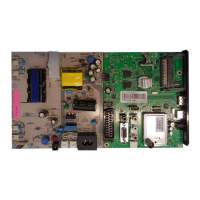
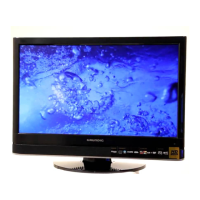


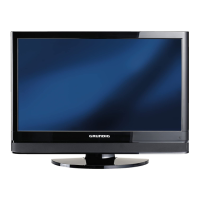
